Every year there are reports of people getting lost in the snow and ice of winter. Mountain rescue callouts are predominantly about navigation errors. To make winter a safer place, it is a good idea to book a guide to lead or alternatively join a group heading out into the hills. Some groups are organised by companies on commercial trips, others are groups of friends or clubs. Nonetheless there is safety in numbers.
Every year there are winter wilderness expeditions running under the guidance of Andy Bateman of Scot Mountain Holidays in the Cairngorms and Glen Affric. There’s also usually a trip to Knoydart, home to Britain’s most remote pub; however there is a major reforestation project going on there this year which makes it less attractive to visit and all the accommodation will be taken by the forestry workers.
Life will be reduced to basics during the expedition and the only concerns will be: eat – sleep – hike (repeat). The perfect way to clear the mind and return feeling completely refreshed after only a few short days.
This is a rare opportunity to experience one of the remotest parts of the Cairngorms National Park at a time when the mountains are probably at their most glorious. The High Cairngorms are renowned for their wintry conditions yet at this time very few folk dare to do multi-day trips
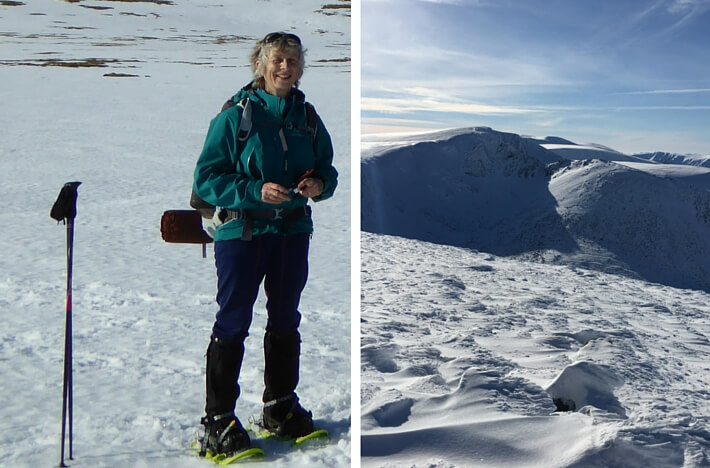
Celia enjoying her second (or third) winter expedition with Scot Mountain Holiadays
Highlights: winter skills, Monadh Mhor (Munro), Devil’s Point (Munro) Carn a’ Mhaim (Munro), Derry Cairngorm (Munro), Beinn a’ Chaorainn (Munro)
Price: £ on application
Email: SCO@scotmountainholidays.com for full information about this trip.
MINIMUM GROUP SIZE: 3 PEOPLE – Private dates available. Please enquire.
This is Scotland’s ultimate winter mountain journey. The high “plateau” route takes in Britain’s 2nd, 3rd, 4th and 5th highest peaks on a journey that circumnavigates Scotland’s finest and best known mountain pass, the Lairig Ghru.
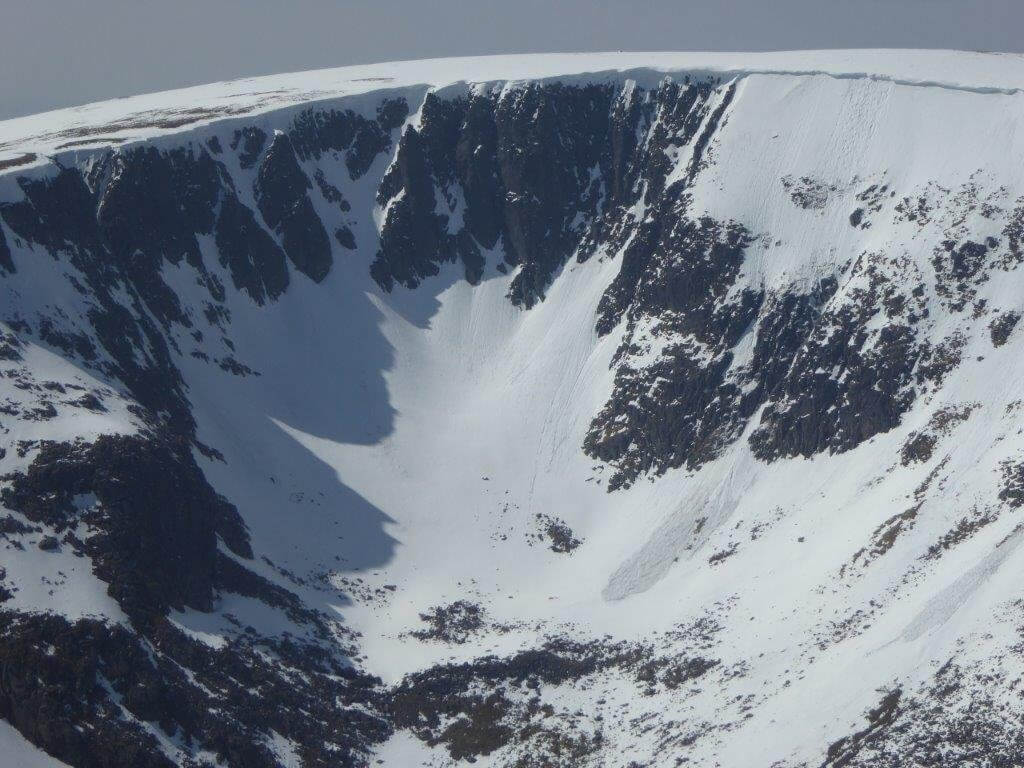
Check out the potential avalanche sites on the head wall. You can see how the corrie came to be made
Highlights: winter skills, Cairngorm (6th Highest Munro), Ben Macdui (2nd Highest Munro), Braeriach (3rd Highest Munro), Cairn Toul (4th Highest Munro), Sgor an Lochain Uaine (Munro)
Price: £ on application
Email: CWO@scotmountainholidays.com for full information about this trip
MINIMUM GROUP SIZE: 3 PEOPLE – Private dates available. Please enquire.
Imagine the soft orange light of a winters dawn gleaming down from the snowy celestial heights. Surrounded by snowy peaks and cradling a mug of tea in the crisp air, indeed a stunning winter’s day beckons.
Highlights: winter skills, Mullach Fraoch – choire (Munro), Mam Sodhail (Munro), Carn Eighe (Munro), An Socach (Munro), Carn a’Choire Ghairbh (Munro)

Spotting deer in Glen Affric while on winter expedition in Scotland
Price: £ on application
Email: Shangri-La@scotmountainholidays.com for full information about this trip
MINIMUM GROUP SIZE: 3 PEOPLE – Private dates available. Please enquire.
Or for something slightly different
“Porridge with whisky at 9am whilst warm & dry in my sleeping bag has never tasted better!” Ric Taylor,Bristol.”
Have you ever dreamt of taking a short walk amongst a moonlit snowy wonderland. Amazingly no need for a torch! Imagine reflected flickering candle light giving way to the soft light of a winters dawn as you emerge from you snowy abode. Not a soul about! We’ll have a vast pristine winter wonderland all to ourselves. It’s a remarkable experience.
Highlights: winter skills on Cairngorm, overnight expedition to sleep in a snow cave, creation of said snow cave

how to build a snowhole in Scotland
All digging and cooking equipment supplied by your hosts, Scot Mountain Holidays.
Check full details on the website
Highlights:
Accommodation: Barrisdale Stable (if available) or heated Tentipi
MINIMUM GROUP SIZE: 3 PEOPLE – Private dates available. Please enquire.
Highlights:
Accommodation: Barrisdale Stable (if available) or heated Tentipi
MINIMUM GROUP SIZE: 3 PEOPLE – Private dates available. Please enquire.
Scottish weather has it’s own reputation. Everyone who comes to visit seems to be prepared to be cold and wet. Many are pleasantly surprised when they come to stay with us. Scotland has a great many ambassadors who spread the world all over the world but there’s no getting away from the fact that it is a green and beautiful land and that green comes at a price sometimes. However, it is possible to minimise the effect a poor weather day could have on your vacation.
A quick comparison between a relief map of Scotland and the annual rainfall map shows a very close correlation. The higher you go the higher the annual rainfall. The altitude of the land can change considerably in a single mile and so can the amount of rainfall both on an annual and daily basis depending on the prevailing wind direction.
The point is, the Scottish Highlands are packed with micro climates and by jumping in the car and placing big mountains between you and the prevailing wind direction, you can massively improve the weather you’ll experience for your day. It can be the difference between frequent heavy down pours and sunshine with the odd very light shower. If active frontal systems are sweeping across the country, well you’re probably going to experience some kind of precipitation at some point wherever you are but if they’ve all passed through and it’s just an air-stream scenario then some judicious planning can pay handsome dividends.
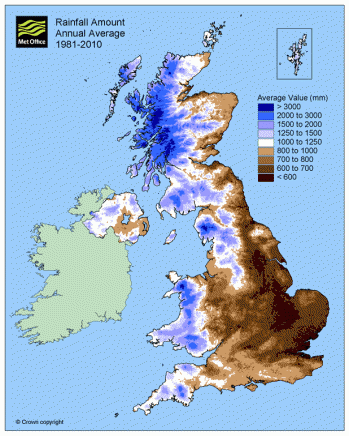
I remember turning up at a house in Glenfeshie one April. I was to guide the group of ladies up from the London area. The forecast for the N. Cairngorms was not good: 70 mph NE winds, blizzards above 800m and torrential rain. I arrived to the gutters overflowing but having studied the weather closely I suggested we jump into the cars for an hour and drive around to Pitlochry on the leeward side of the range to do Ben Vrackie. The suggestion wasn’t greeted with any enthusiasm and possibly a certain amount of doubt but the thought of an hour in a dry bus was better than an extra hour walking in the heavy rain.
As soon as we passed over Drumochter Pass the weather started to improve (as is often the case) and by the time we got around to Pitlochry we were in sunshine to the comment of “Andy, haven’t you done well”. We had clear views from the summit, albeit in a strong bitter wind. On passing back over the pass we drove back into the bad weather. ‘Had it been wet and horrible all day’ I asked Rebecca, my partner. “Yes’ was the answer.
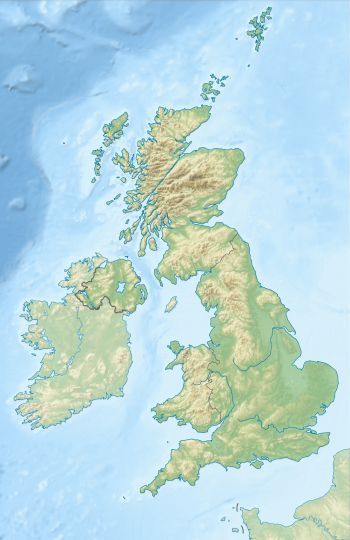
The prevailing weather/wind direction makes a big difference. If there’s bad weather on the way make sure you’re on the sheltered lee side of big mountain ranges. One of the most common comments made by visitors is how changeable the weather is.Don’t judge the days’ weather by what’s happening at breakfast.
So when it comes to planning your tour, if you can remain flexible and not book things too far in advance it can often make a big difference. Avoiding the high season from the middle ofJuly until the end of August can be a big help in this regard. April & May can produce some of the best weather.
The vast majority of Scotland’s bad weather comes in from the south and west. You will notice the east side of the country is considerably drier than the west. In fact the west coast ofScotlandcan receive up to 3 times the annual rainfall of the east. So by basing yourself, for example, in Strathspey or in the North East side of the Cairngorms National Park you can often greatly increase your chances of experiencing better weather. Also, with easy access to the main road routes to Ullapool in the North West Highlands and Fort William in the West Highlands are only 1hr 40mins and 1hr 30mins away respectively from Aviemore it’s easy to make a foray into these areas.
This is you buying into in-depth local knowledge of suitable locations with regards to the weather conditions. Adventure activities also provide you with the opportunity to immerse yourself in the beautiful landscapes and amazing wildlife of the Scottish Highlands.
Adventure Tour Operators in Scotland
Highlands and Islands Adventures (mountain biking specialists)
Walking holiday providers in Scotland
A visit to Glenlivet Mountain Bike Centre will take at least half a day, especially if you treat yourself to a bite to eat at the Coffee Still. Let the kids loose on the practice track while you wait for your food as then you can relax and they’ll be happy whizzing round and round.
Distance from Fraoch Lodge: 30 minutes drive
Routes: Red (22km) and Blue (9km)
Cafe: Yes
Toilets: Yes
Showers: No
Bike Wash: Free
Bike hire available: yes
Blue route is ideal for families and even has the unusual feature of starting on a downhill section, followed by a zig-zag climb which is not too difficult to manage before more free flowing downhill track which seems to go on forever. There is one wee steep climbing section in the middle, but you know you’ll be rewarded with even more great cross country downhill track afterwards.
Photo caption: Blue trail, Glenlivet: free flowing downhill on very well made tracks area delight for younger riders. Very few roots to negotiate and few if any areas prone to sticky mud.
Photo caption: The uphill section on the zig zag section of the blue route which offers spectacular views over the wider Glenlivet area.
Photo caption: the Coffee Still is a purpose built cafe and wee store supplying a small selection of emergency biking products. You can purchase coffee, cake and a small selection of very good hot food snacks and light meals from chicken fillet buns to pizzas. The menu is not hugely extensive but what is on offer is extremely well-done and very high quality, using as much local produce as possible.
Practice track
A trail map is available to download or you can purchase an A3 foldable version from the cafe when you are on site.
Afterwards:
Treat yourself to a stop in Tomintoul which is a stone’s throw from the bridge where you turn to head over to the bike tracks.
In Tomintoul you can:
Email us if you think we can help plan your vacation in Scotland – we can hit all the Highland hotspots and include some off the beaten track surprises you might not know about.
For inspiration check out our Pinterest board and our Flickr account.
It’s no secret that exercise is extraordinarily beneficial to achieving a happy, healthy lifestyle. Extensive research states that exercise not only improves physical health but also works wonders on mental health, and guided hiking health benefits are no different.
Hiking uses some of the body’s biggest muscles resulting in an all-body workout. The legs, doing the grunt work will result in a workout of the gluteus maximus, quadriceps, hamstrings and calves. Hiking also strengthens the back and the abdominal improving overall stamina and endurance.
But it goes deeper then improving physical changes. The physical effort required in uphill walking strengthens the performance of the heart and lungs whilst lowering blood pressure. Studies have also shown that hiking and mountain walking reduces the risk of chronic illnesses, asthma and type 2 diabetes.
Mental health is extremely important and hiking is an amazing tool in benefiting this positively. The physical changes from mountain walking are a great incentive to continue exercising. They also work wonders with improving self-esteem and self-awareness. Due to the heightened mental concentration hiking requires it strengthens mental agility, helps sharpen brain activity and is an amazing stress reliever. And hiking can be challenging. But successfully completing such a strenuous activity gives you a great sense of achievement and a positive headspace.
Group hiking is just another point to put on the pro list. Guided hiking with Scot Mountain Holidays gives you have a leader to follow, eliminating the stress of figuring out where you are and allowing you to fully concentrate on the task at hand. The group aspect also builds social bonds and completing challenges together will develop strong friendships and trust.
The truly great thing about hiking is that not only do you get the fantastic physical, mental and social benefits, but everything is enhanced due to the exposure of the elements. Along with burning calories you will profit from vitamin D, fresh air and more.
For more information on guided walking visit Scot Mountain Holidays and Courses.
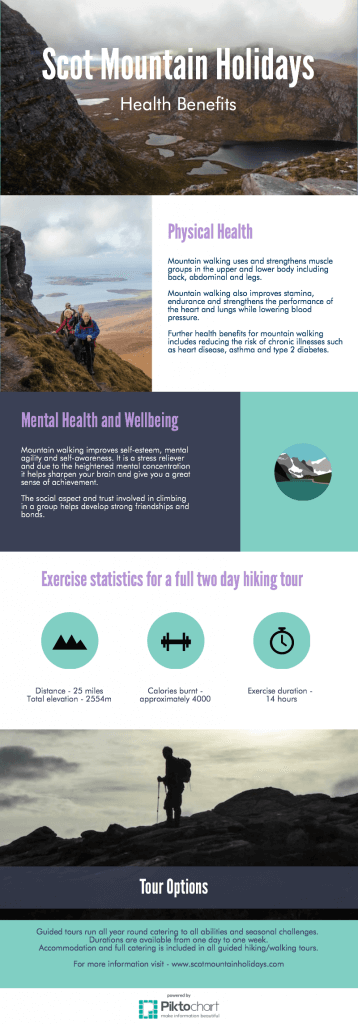
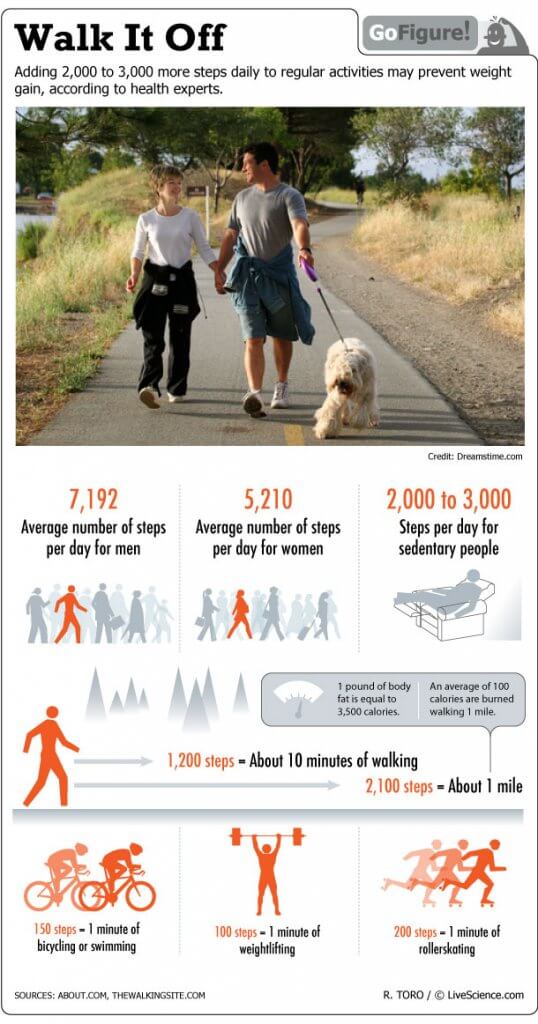
The benefits of walking far outweigh many other forms of exercising, including going to the gym.
Top 50 Long Distance Hiking Trails In The USA
19 Physical and Mental benefits of spending time outdoors
We are frequently asked what to pack for a day hike in the Highlands, usually by our guests preparing for their guided walking tour with us. People often ponder on whether they should pack shorts, a sun hat, sunscreen. What gloves to bring etc – the list goes on.
Bear in mind, that if you are planning to head out on your own or at least without a guide, then you will also need to pack the following gear and be familiar with how to use it.
map & compass: you will need a good quality, local, walking map such as Harveys or Ordnance Survey (we stock the 1:50,000 OS map for our area). Do not rely on your mobile phone mapping.
You should also always pack some food (even small snacks) and some water. It is possible to refill your water bottle along the route, but take care if you are following a low level popular path. If there is a lot of livestock in the area, it would be best not to refill your bottle unless you have a water purifier with you.
Always tempting if you happen to strike the good weather to whip out the shorts to go for a hike. It is however worth bearing in mind that Scotland is not without its pests. There are ticks in Scotland which hang on the undergrowth, particularly at low levels waiting for someone or something to come past. Ticks are often carried by deer who rub them off on the vegetation. The ticks wait there for the next host to continue their life cycle. They can wait for years.
If you do pick up a tick it is not the end of the world. There is Lymes Disease in the UK which can be treated with antibiotics – but early removal of the tick is key to the prevention of the disease. We have tick removers here at Fraoch Lodge. Make sure you check yourself over at the end of the day. However, you can minimise the risk of picking up a tick by wearing long trousers and gaiters over the top of your boots. Generally speaking dog walkers and golfers are often at more risk than hikers of returning with ticks.
Unless you’re going to be battling through particularly overgrown parts of the countryside, the length of your sleeves is not too vital and the rate at which you get cold will determine whether you think long or short sleeves suitable for the day.
There are not many well graded, smooth paths in the Scottish hills. Most tracks are relatively rough with loose stones and rocks. It is usually sensible to use over the ankle walking boots to protect your ankles from turning and also to keep your feet as dry as possible. Leather boots, though heavier, should provide the best protection and will be generally more waterproof than gortex lined fabric boots.
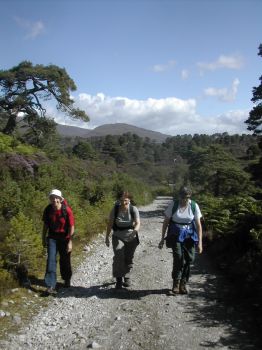
Waterproof shell jackets are by far the most popular. Most shops stock a wide range of jackets designed with gortex fabric. Andy himself prefers to wear Paramo clothing or Cioch direct waterproofs. Both these companies use the same material. Cioch Direct specialise in made to measure clothing. The advantage that the Nikwax analogue material has over gortex is that it is designed to be reproofed after washing so is likely to last you longer. The jackets can also be returned for repairs at little or no cost. The disadvantage is that the material is heavier and can prove to be too warm in the height of the summer – though at an average year round temperature of 0oC, the Paramo jackets are usually suitable for the Cairngorm plateau.
Always useful to include a warm hat and gloves at the bottom of your pack as it can be cool on the hill tops even in August.
The most sensible attitude to your clothing for hiking is to make sure you have several light layers which will provide maximum flexibility rather than one or 2 choices. Make sure that your layers are not cotton options as you could cool off very rapidly, should your cotton layer become damp whereas synthetic or wool layers will either dry more rapidly or stop you from cooling down too much.
The most useful size of packpack to bring with you is a 35 litre pack. This will be large enough to take all excess clothing, camera, packed lunch etc. Smaller than this may mean that you have to limit what you take on the hill, particularly in winter.
Wandering into the Cairngorms
Please don’t hesitate to contact us if you have any queries about the clothing/gear you are intending to bring with you for your Scottish vacation.
If you’d like to book a guide for your day hike, please don’t hesitate to get in touch with us. Andy is extremely knowledgeable about the Highlands of Scotland from history to nature and everything in between. A hike with him is an introduction to everything you wanted to know.
Email: info at scotmountainholidays.com
Tel: +44 1479 831 331
Salmon has been associated with Scotland for many a year, both for fishing and for eating. It is world renowned as a quality product, despite the problems which have occasionally been associated with the salmon farming industry. Farmed salmon is really the only option now. Gone are the days when apprentices had it written into their contracts that they weren’t allowed to eat salmon more than 6 days a week!
“Salmon is now by far the biggest food export from Scotland. In 2014, it beat confectionery to become the UK’s biggest food export. “
Salmon has been part of the tourism and the catering industries in Scotland for many a year. It is far healthier than most of our other food products. It’s always a popular option on our menus.
BTW – if you though it was expensive to buy salmon here in Scotland, try visiting New Zealand! We didn’t buy any salmon when we were over there. It seemed really expensive in the supermarket.
11 health benefits of eating salmon
Check out some of the great recipes we have used to make the most of our salmon options.
Classic Smoked Salmon on oatcakes
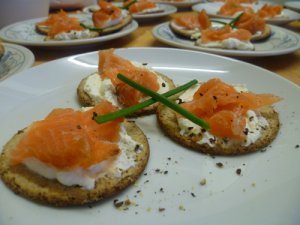
One pan salmon with roasted asparagus

Asian sticky salmon
This is one of our favourites when we’re feeling generous – a very Scottish mix of salmon and whisky.
Salmon in whisky sauce
125g unsalted butter
1 carrot
1 stick of celery
4 salmon fillets
2 tbs olive oil
2 tbs whisky
4 tbs single cream
salt and pepper
spinach to serve
Melt 25g of butter in a small pan. Add carrot and celery and cook for 10 – 15 mins.
Dry salmon fillets then rub with oil & season on both sides.
Heat oil until hot then add salmon fillets (skin first, if they have the skin on). Cook for 6 – 8 mins each side. Longer if they are thick fillets.
Add the whisky to the vegetables and boil for 1 – 2 mins to reduce liquid by half.
Add cream and remaining butter until sauce is thick and rich looking.
NB We have also seen Salmon jerky for sale in limited stockists, but have yet to try for ourselves. For the moment, we’ll reserve judgement but we’ll let you know when we’ve managed to get hold of some to try.
Salmon leaps in or near the Cairngorms National Park – Pitlochry and Rogie Falls are the salmon leaps we know the most about. We have seen salmon leaping at Rogie Falls. We took photos, but it wan’t easy to see on the camera.
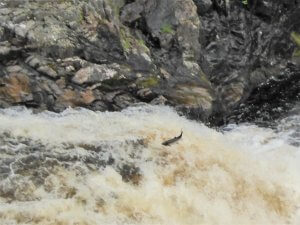
Salmon leaping at Rogie Falls
Salmon leap blog from VisitScotland
Fishing – we’re not experts on the fishing opportunities here in the Cairngorms but both the River Spey and the River Dee are world renowned for salmon fishing. However, don’t expect to take your catch home with you, unless you catch a rogue farmed salmon.
Atlantic Salmon facts from Scottish Natural Heritage
Further details about: How Scottish Salmon conquered the world
World’s restaurants take wild salmon off the menu
Andy Bateman of Scot Mountain Holidays leads at least 3 commercial snow hole expeditions in the Cairngorms Mountains every winter season. He has introduced scores of people to the magic of the winter season. He is also an expert at the skill of building a snow hole for a drip free night out in the mountains. To see what snowholing expedition experience is like for the customer check out our video on YouTube:
Seasonal temperatures on the high hills in Scotland are never as low as those in the valleys. You need to take this into consideration when planning to snowhole. Here in Boat of Garten we get temperatures of around -20oC. The lowest ever recorded temperature on the summit of Cairngorm is -16.5oC. Cold temperatures in the valley always occur under cold settled conditions. This is when the cold air drains off the mountain. The cold air then pools in the bottom of the valley. This means that in the Cairngorms the temperatures are never as low as in Norway.
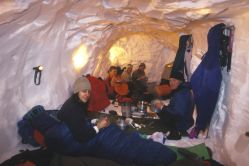
Enjoying an evening meal in the luxury palace makes the snowholing expedition unforgettable!
In Norway, you need to capture the warm air. Most people learn to build snow caves in Norway. They learn to create features which capture the warm air inside the shelter. In Scotland, however, you are operating much close to the melting temperature of snow so sloping entrances, sleeping platforms and cold air drains become much less important for the snow hole expedition.
Roof sag is a combination of the temperature rising too much, poor ventilation and not having a thick enough roof or having a large area of unsupported roof. A roof and front wall of approx. 1m thick is vital. If daylight can be seen through either the roof or the wall, they are probably too thin. However, bear in mind that a roof that thick will need an adequately thick & strong front wall.
Avoid large areas of unsupported roof by keeping your snow hole more like a tunnel, narrow. Aim for a distance of no more than 2 body widths, side by side lengthwise. This means you can create a steep-angled apex ceiling which helps to avoid any drip points and allows you to channel warm air towards ventilation holes.
Many snowhole sites by virtue of their high snow accumulation and steep slopes are prone to avalanches. To be safe, you may need to pick a slope with a more gentle gradient and spend more time digging into the slope. To maintain a 1m thick roof on a 30 degree slope you will have to dig horizontally 2m from the top of the doorway before widening out.
Make sure there is good ventilation and regularly watch your breath then you will avoid carbon monoxide poisoning. If you see it drifting off to one side, it’s a good indication that ventilation is adequate. Never cook in a snowhole without regularly checking there is adequate ventilation.
It’s a good idea to create ventilation holes in your snow hole because of the Scottish climatic conditions.
Make your snow hole large enough to stand up in so you don’t get back ache from crouching.
One potential hazard of digging a small snow hole is that you don’t have enough space to put the snow when you attempt to extricate yourself in the morning. One of the snowholes Andy built in the Cairngorms involved digging out through 1.5m of fresh, drifted snow to get out in the morning.
Never underestimate how hard the Scottish snow pack could be. At least make sure your snow shovel has a metal scoop and that you are also carrying a snow saw.
Time taken to construct your snow hole is vital. A communal snow hole can take 4 – 5 hours to dig to make sure that you have the best construction possible.
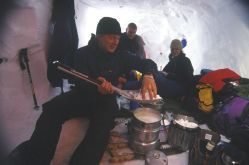
See more about our snow hole expedition!
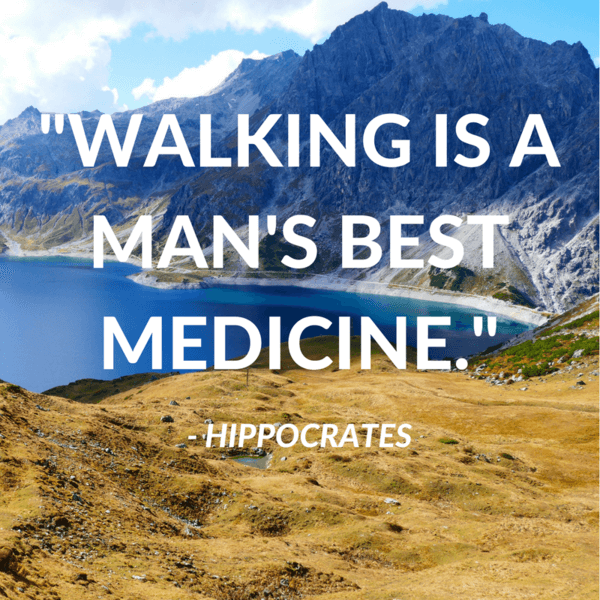
Researching where to hike in Scotland is not necessarily an easy task You probably have access to such sites as WalkHighlands. We’ve recently come back from New Zealand. While there we toured the North Island (but not the south, despite frequent recommendations to go there). We didn’t take a campervan (despite recommendations) but we did hike the Tongariro Crossing. However, even though we speak English, we found it much more difficult to get an idea of where to go to hike on the North Island and what to expect when we got there.
What you have to bear in mind when you’re planning your trip, is who is giving you recommendations. Are their priorities are similar to yours or not? Just because someone else thought it was great to isolate themselves in a campervan, doesn’t mean that it will be your thing – nor that it will be within your budget. Equally when someone recommends a hike to you – this doesn’t always mean that it is the best the area has to offer.
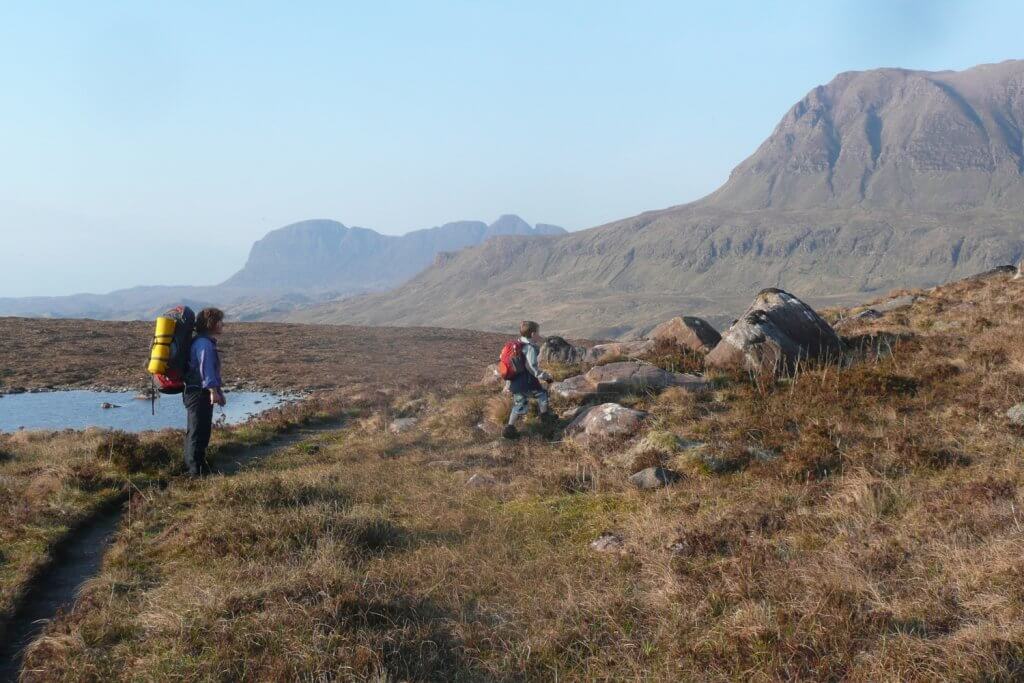
Hiking in to a secret wild camping spot in Assynt
What are your priorities?
Is time going to be an issue? Can you afford to be relatively spontaneous? Remember sometimes it’s the experiences you haven’t planned which end up being some of the most memorable parts of your trip. For example, before we went to New Zealand we knew we would spend most of our time on the North Island. We knew we’d be spending the first week in Taranaki, visiting family. We thought we’d like to go on through Taupo, Rotorua and the Coromandel peninsula including the Tongariro Crossing along the way.
In the end, we only passed through Rotorua and diverted to Lake Waikaremoana. This is one of the North Island’s few “Great Walks” (as designated by the Department of Conservation). The walk was stunning and not popular at all. Around 90% of visitors are Kiwis. We loved the whole experience because it was remote. The few people we met were extremely friendly, the views were amazing and we were surrounded by nature. We saw more wildlife on this hike than on all the others put together.
Are you using images on social media to influence your choice?
The problem with using social media to help you decide where to go is that 1000s of other people are seeing the same images. When you get there you might be disappointed when the reality doesn’t match up with the (probably) enhanced image you’ve seen. You will also probably find that the place is much more popular than you anticipated. If you, as a first time visitor to the area, have found information about this place, and seen it more than once, the likelihood is that many other travellers have too.
When making your choice of where to hike in Scotland, bear in mind that you are likely to meet many other people on the shorter hikes on Skye, but many of the other Hebridean islands will be just as beautiful and much less crowded (except during HebFest).
If you choice where to hike in Scotland includes the West Highland Way, this is the most popular long distance hike in Scotland – try to go off season if you can. It will be much less crowded in October than July. NB High season on the West Highland Way also co-incides with high season for midges.
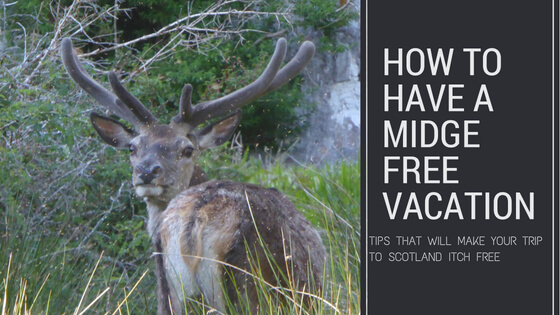
Speak to local people about alternative options. Ask experts for advice or take a knowledgeable, local guide. Most hiking guides will avoid popular hotspots. They endeavour to take you to places you wouldn’t otherwise reach.
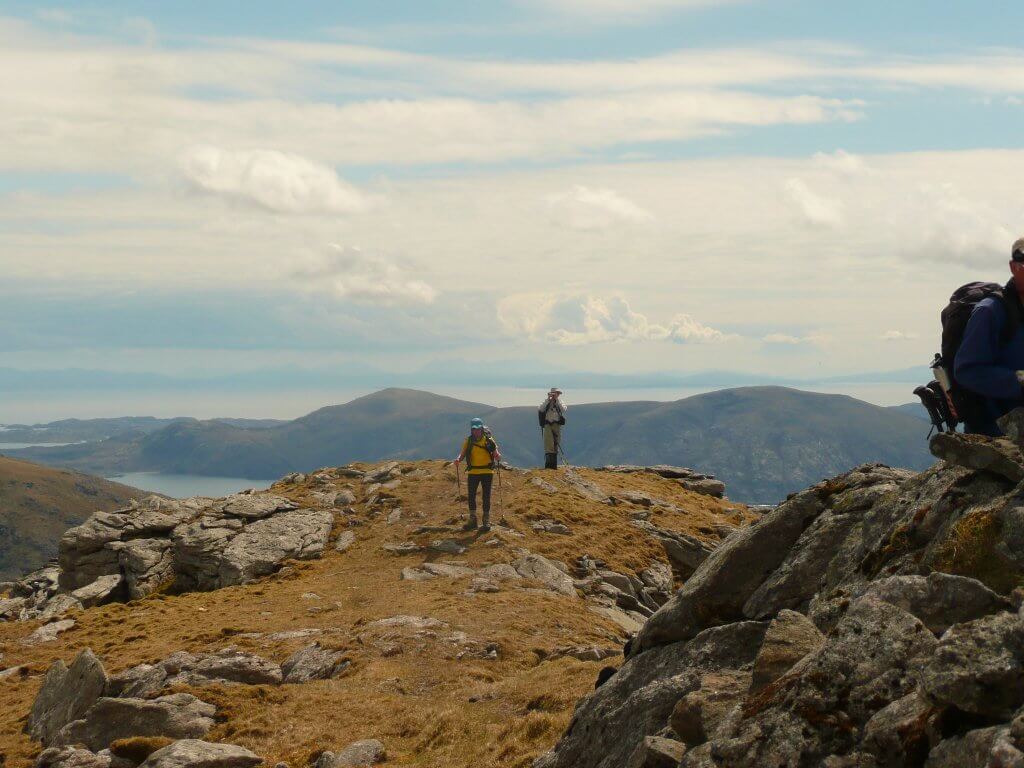
Exploring the hills of Harris. Watch out though there are few if any way marked paths which might come as a shock to some of our continental visitors.
Sometimes the highlight of a hike in Scotland is a chance encounter with reindeer, red deer, red squirrels, ptarmigan, … there’s quite an extensive list. Your chances of seeing wildlife during your hike in Scotland are greatly reduced if you choose a popular route. Wildlife in almost all circumstances will avoid areas where there are a lot of people.
Top tips for wildlife sightings
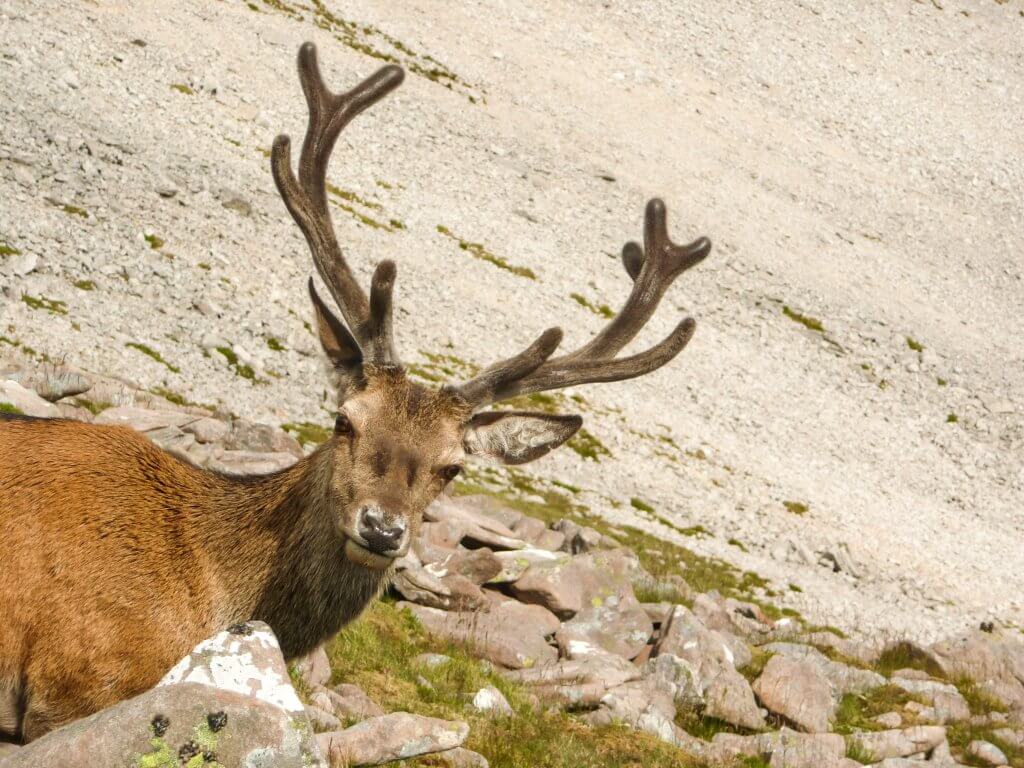
All the best when it comes round to your turn to choose a hike in Scotland. There are some great books, but if you can afford it we would highly recommend booking a guide for your first walk. You’d get a much better feel for the country and probably learn some unexpected trivia!
Midges in Scotland have a reputation which far outweighs their size, but perhaps not their numbers.
Here in Scotland, we’re not subtle in our campaign to drive the visitors away. We emphasise the rain and then we start with the midge stories. And still people want to come. Well we’ve come up with a plan for you. We’re going to try and make sure you go back home without mentioning midge horror stories and without any stories of being drenched by rain. Our plan: visit the east.
In the Highlands of Scotland, particularly in the Cairngorms, we can have an early frost in September or a late frost in May. Midges can’t survive a frost. If you arrive in Scotland, before the weather has warmed up too much you are unlikely to see many midges. Also if you visit in May or early September, you are also likely to encounter the best weather conditions Scotland has to offer. May 2018 (and June) have been exceptional in sunlight terms, but there is also now an increasing issue with the swarms of midges. Over on the west coast, it can be difficult to find builders at this time of year. Their work requires that they remain stationary or at least around the same site for extended periods of time, and the midges just won’t leave them alone. However, direct sunlight and windy conditions do mean that there are few if any midges around.
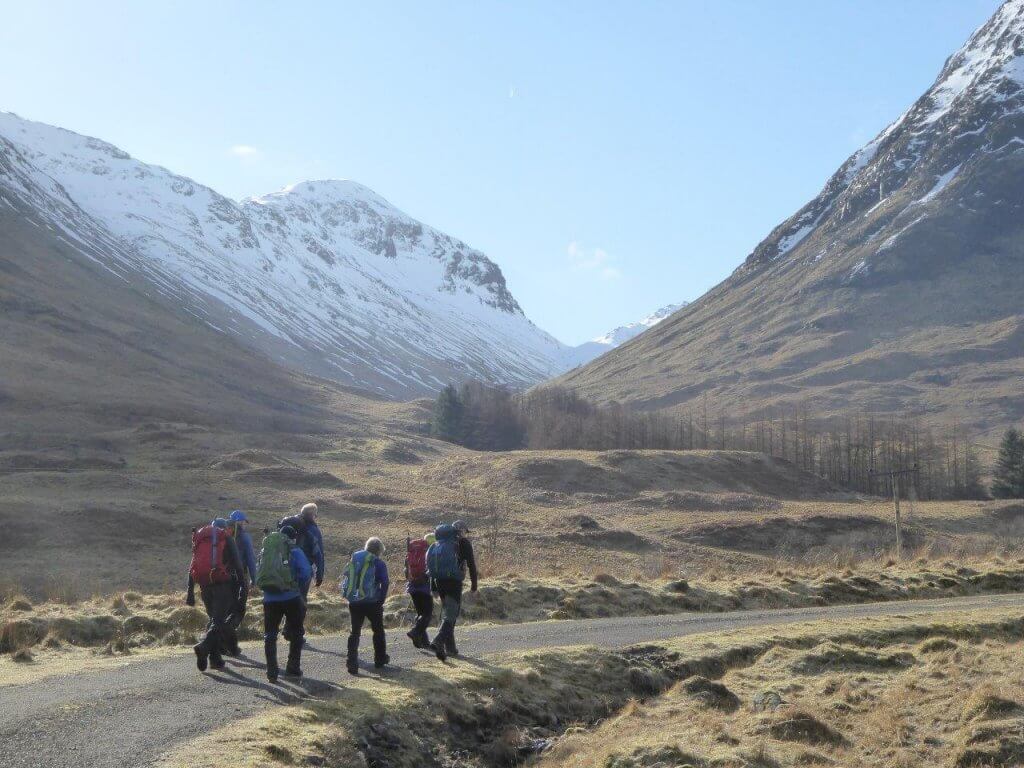
This photo was taken in Glencoe in March. This is when you can really enjoy hiking in the area. There is still snow on the ground, so it is not for the faint-hearted but there are no midges in Scotland and the air clarity is amazing. Perfect for photography.
We plan all our west coast walking holidays around both the best weather conditions and the height of the midge season. We rarely if ever, go to the west of Scotland between June and the end of August.
We have our home base in Boat of Garten in the Cairngorms National Park for a number of reasons. High on the list is the lack of midges, in general. On a still, damp morning/evening, you definitely become aware of their presence in season, but more often than not we rarely encounter them. They can be a bother in the Cairngorms, but the drier weather here and the sometimes windy conditions, keep the levels of midge down to manageable levels.
Midges in Scotland do love damp forest conditions though as the trees provide them with shelter from the wind and the sun, so be careful if you picnic in the woods.
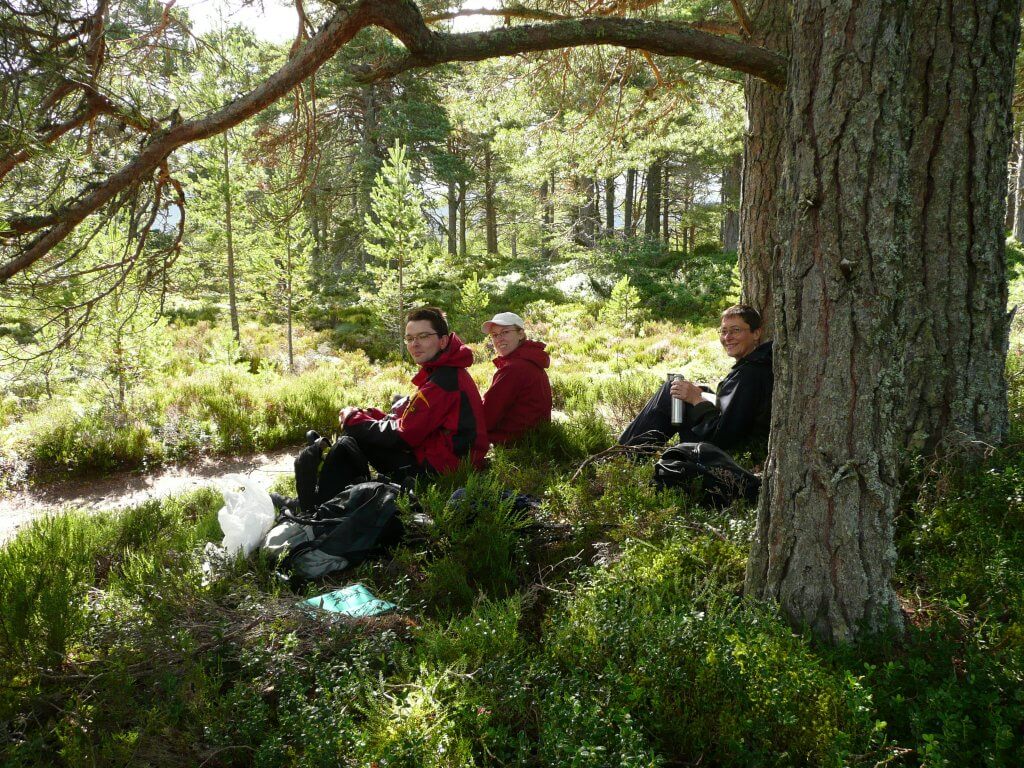
Relaxing in the shelter of the trees – beware the midges on a wind free day.
On still, damp days our best advice would be to engage in something high speed (eg mountain biking or road biking or zip lining) which will keep the midges away from you as you generate your own “wind” ie slip stream. You’ll be moving too fast for them to keep up.
Failing something high adrenaline you could just admire the scenery from the seclusion of your car, being sure to insulate yourself from the outdoors with your air conditioning system or alternatively indulge yourself in a bit of culture or city life for the day.
There are plenty of museums you can visit, even in the Highlands. Or try a castle or distillery.
We recommend the following distillery tours:
Tomatin (especially if you have under-18s in your party)
Glenlivet (regular tours which are translated into most major European languages)
Glenfarclas (a more unique and family atmosphere than other distilleries)
Aberlour (highly regarded and recommended to us)
Or try to Speyside Cooperage – a unique opportunity to see the traditional coopers at work making and refurbishing the casks which are a vital part of the whisky industry.
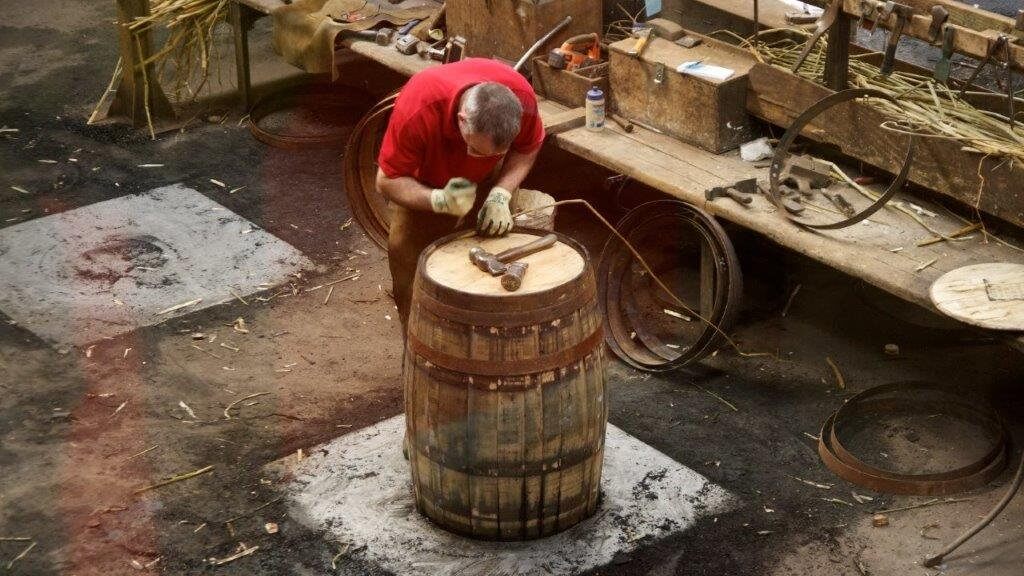
A cooper hard at work repairing casks at the Speyside Cooperage
Midges are so tiny that they can’t tolerate any more than a very light breeze. There is a fine balance in how much wind you can enjoy before it starts to affect your enjoyment of your day out, but hopefully you will find there is a strong enough breeze to keep the midges away, but not too strong to prevent you from enjoying your hike. The strength of wind you can tolerate yourself will depend on your experience and body mass. If the wind is starting to push you around, you’ll stop enjoying your day out and be concentrating too much on trying to maintain a straight line to your destination.
This is probably the hardest one to do if this is your dream vacation to Scotland. Almost everyone has at least one west coast destination on their itinerary, usually Skye. Stock up on plenty of repellent if you’re heading over between June and mid-September.
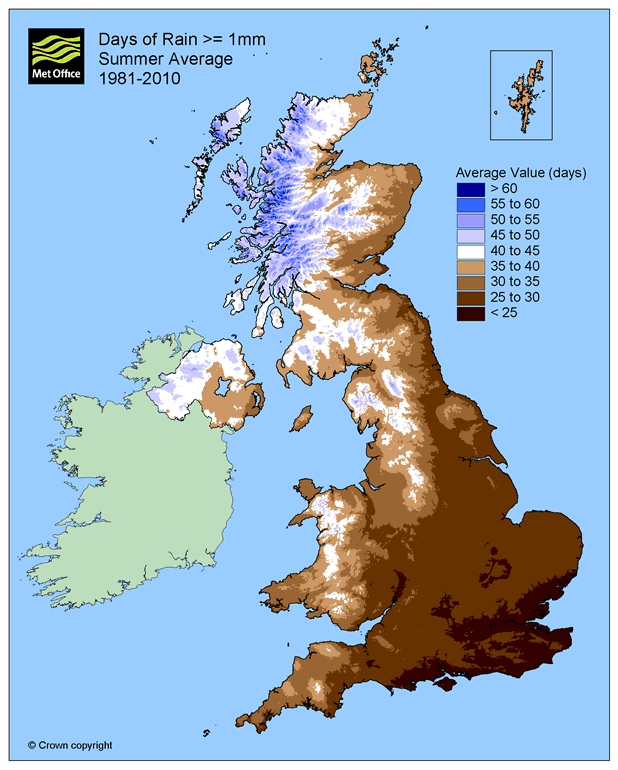
This is relatively easy advice to follow in early summer as dawn takes place so early and dusk so late, but by August it is worth being aware of the sunrise and sunset times.
If you’re planning an active vacation in Scotland, it’s worth checking out our programme as we have planned to include the best of the weather and the best of the midge free opportunities across the Highlands. We can also plan a tailor-made trip for you. If you base yourself with us we have good access to most other areas of the Highlands (except Skye and the Outer Hebrides) and can make the most of the best weather where ever it is.
Other precautions you can take:
For a light-hearted summary take a look at the video below:
There’s no getting away from the fact that if you visit Scotland in the summer you will quickly find out that there are midges in Scotland. If you go hiking in Canada and parts of the US, you need to carry bear spray with you. We don’t have any pests on the same scale as that, but you have no doubt heard about the Scottish midge. It seems to be a scary prospect for a large number of people intending to come and visit Scotland. They can be of plaque proportions sometimes but over here in the dry East of Scotland, we really don’t suffer from swarms of midges at all.
If you’re concerned about the prospect of midges bear the following tips in mind:
Midge facts from the makers of Smidge – a repellent which works.
2. Use repellent, naturally based if possible as deet is not kind to the skin. (A chemical which will melt a plastic bag is surely not designed to be used on the skin repeatedly over an extended period?)
3. Purchase a midge net
4. Use citronella, lavender or bog myrtle candles – preferably in a well-ventilated place or outdoors.
You’ll find that a midge bite from midges in Scotland is itchy and annoying but doesn’t have any long lasting effects. It won’t have any impact on your health long-term. The real pest to be wary of is the tick. I don’t hear anywhere near as much discussion about ticks from visitors planning to come to Scotland, but there is a risk that you should be aware of. Ticks don’t just bite dogs. They don’t just affect hill walkers – in fact, you can be at risk of a tick bite on a dog walk or playing golf.
Midge solutions
[amazon_link asins=’B01EJF6LAE,B00413715E,B002MDAOSQ,B06XKKS2JX’ template=’ProductCarousel’ store=’1603-8102-0783′ marketplace=’UK’ link_id=’1d95a286-6f07-11e8-889b-abcc7d60ddfc’]
Most of the west coast including Skye, Torridon and Arran.
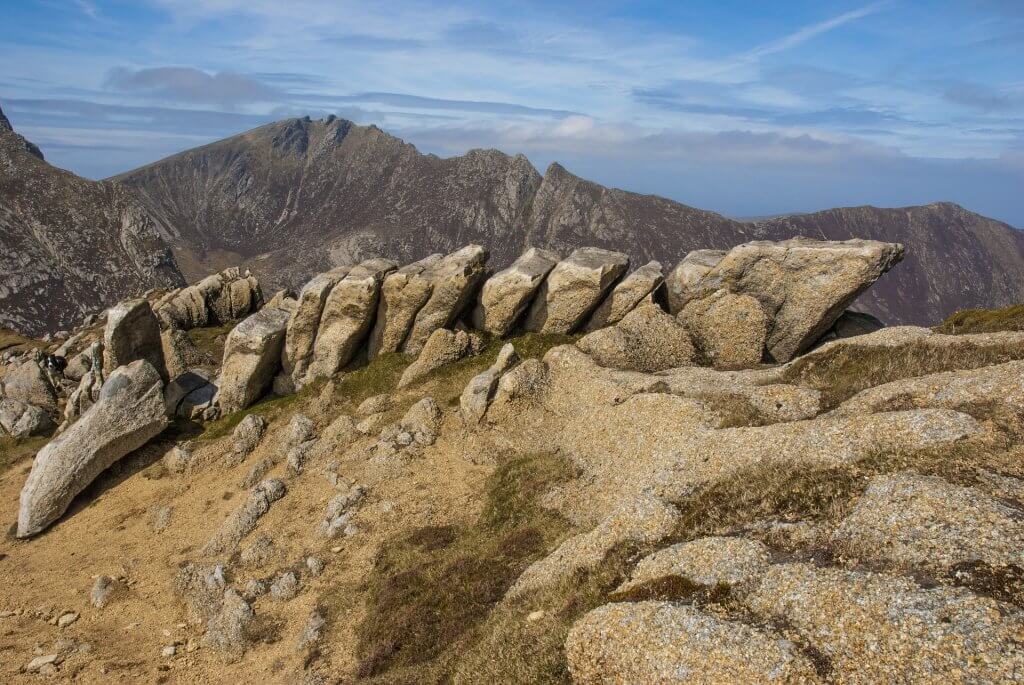
The peaks of Arran
We camped on Arran one year to check out some new routes we were planning to offer our clients. Found the perfect spot to wild camp, set up the tent, (nice breeze blowing all the while). Woke up, unzipped the tent and rapidly zipped it up again. At some point in the night, the breeze stopped and the midge clouds arrived.
You’re most at risk of tick bites if you venture off the main path and brush against any undergrowth as this is where the ticks like to hang out.
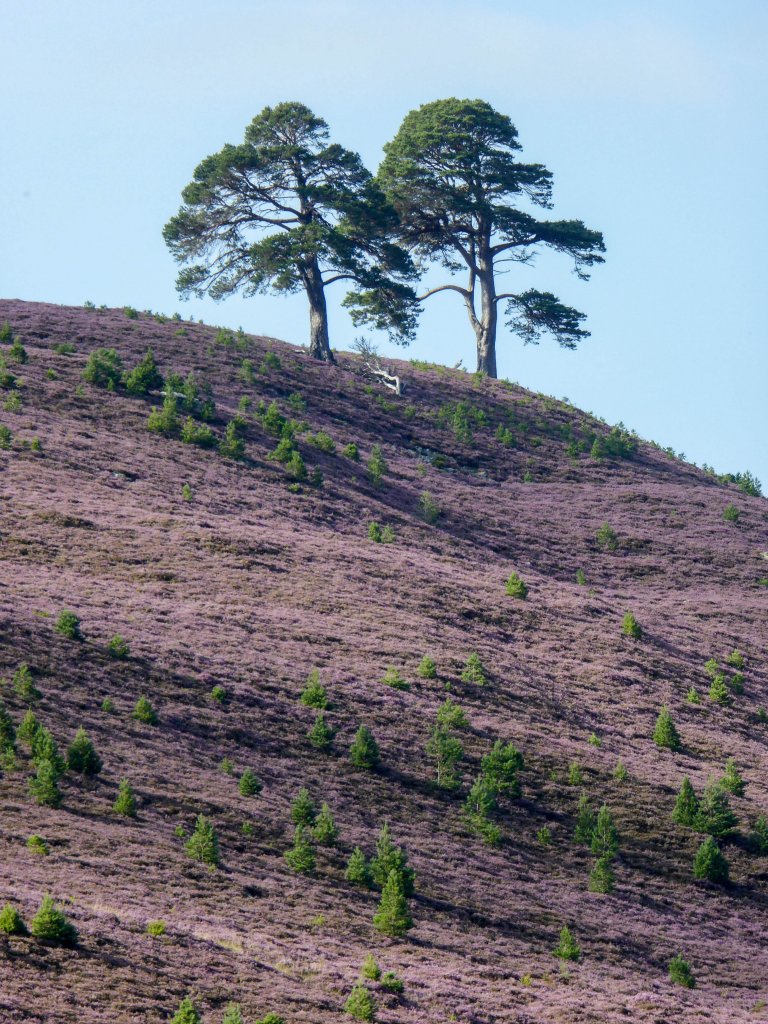
Most Scottish hill walkers are aware of the risk of Lyme disease and do check for ticks when they shower at the end of the day. Some of them can be so tiny that they are very difficult to spot. You pick them up from the undergrowth, just as dogs do. They can hang from the under side of ferns for years waiting for a host to come along. They don’t fly, but they will crawl on you until they find a spot they find warm and dark to attach to you. The most common places to find them are behind your knees, in your groin, or if you’re female, around your boobs.
A tick bite won’t be painful when it attaches to you and it will fall off on its own if left. Once it has finished it’s blood meal. However, it is definitely a good idea to remove it as soon as you can to reduce the risk of Lyme Disease.
Do not just pull a tick off if you find one attached to you. My personal early warning system is that I find a tick bite very itchy, worse (per bite) than a midge bite. If you just pull a tick you risk leaving it’s head attached to you. Also if you squeeze it while detaching it from you, you can force it to regurgitate it’s stomach contents into your bloodstream which will increase the risk of Lyme’s disease.
Tick twisters
[amazon_link asins=’B0037DD27U,B072JXRRBQ’ template=’ProductCarousel’ store=’1603-8102-0783′ marketplace=’UK’ link_id=’278ba43b-6f06-11e8-bce5-0727019eda1e’]
Tick lasso
[amazon_link asins=’B001QC34LS’ template=’ProductCarousel’ store=’1603-8102-0783′ marketplace=’UK’ link_id=’32301992-6f06-11e8-87f8-41d3dad923df’]
Tick map and predictions for the future
We rarely see swarms of midges on our guided hiking holidays.
There are midge hotspots in the Cairngorms, but it really is nothing like the west coast. Linn of Dee can be a wee bit midge infested if you’re hanging around before setting off into the Lairig Ghru, and if you’re at Corrour Bothy in the evening, you’ll possibly see a fair few – but we rarely have to put off our gardening. If we had more time to enjoy the garden we could without being bothered by midges.
All content © Copyright Scot Mountain Holidays 2025
Responsive web design by Summit Web Solutions